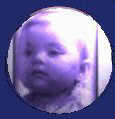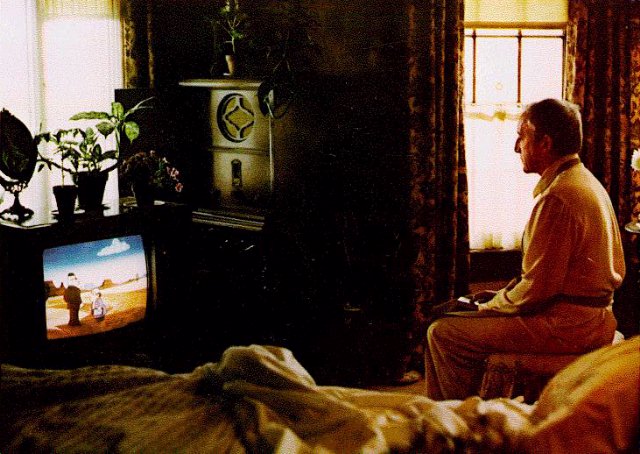| Author |
 Topic Topic  |
|
|

Joe Blevins 
"Don't I look handsome?"
|
 Posted - 11/18/2012 : 07:55:20 Posted - 11/18/2012 : 07:55:20


|
No, not really. But I'm kind of shocked that this hasn't been done yet. I mean, we've seen every other kind of digital tweaking of older movies, from colorization to 3D conversion. Has anyone thought of adding sides that weren't originally there, just to fill up the screen?
Normally, when a studio wants to pretend that a movie is widescreen, it just lops off the top and bottom of the picture. Disney did that to Peter Pan, for instance, when it was re-released to theaters. At the complete opposite end of the spectrum, John Waters' Pink Flamingos is only available in a simulated widescreen version, even though it was shot on 16mm film and should only take up the middle of the screen.
It's no big loss with the Waters film, frankly. He was acting as his own cinematographer at the time, and to say the least, his attempts at framing and composition were perfunctory at best. The fake widescreen version actually looks a little better than the original, since it loses much of the "dead space" at the top and bottom of the frame. Waters himself is happy with it, though he did lament the fact that some hairstyles and shoes were no longer visible. In the case of a meticulously animated Disney film, however, any artificial change to the aspect ratio can spoil the composition or omit visual information. In recent years, Disney has been careful about preserving its classic films as they were originally intended.
But what do you do with those black bars at the sides of the screen. On the Pinocchio DVD, there's the option of watching the film with specially-designed borders which reflect the mood of each individual scene. But with today's technology, it seems like it would be possible (though unethical) to fill in those gaps with animation that matches what's in the middle of the frame. And the same idea could be applied to live-action films, too. What would have been visible just beyond the frame in, say, Casablanca? I imagine that a CGI effects artist could fill that space in with some approximation of action that matches the original film.
Keep in mind, I'm in no way advocating this idea. I'm just curious whether anyone has attempted such a thing. |
|
|

Sean 
"Necrosphenisciform anthropophagist."
|
 Posted - 11/18/2012 : 10:38:27 Posted - 11/18/2012 : 10:38:27


|
I've never heard of anyone doing this. I can imagine it would be very, very expensive and no studio would get their money back on it on any movie.
I don't mind the black bars at the side, sure, I'd rather they weren't there but I find it definitely preferable to cropping. I never zoom in on a 4:3 movie to fill the screen.
|
 |
|
|

BaftaBaby 
"Always entranced by cinema."
|
 Posted - 11/18/2012 : 11:36:14 Posted - 11/18/2012 : 11:36:14


|
You're so right to point this out, Joe. And, nope, I've not heard of modern technology being used in this potentially dubious way. But, two things occur:
1. There are a few, VERY few, wonderful examples of directors able to tell triptych tales from the earliest days of cinema. The best, imho, are from French genius Abel Gance - the main focus was always in the middle - but to each side were either mirror images which enhanced the action, or two different enhancements. If that makes sense.
2. Disney has just informed me that the studio is sending out a package of BAFTA viewing copies of this year's output -- can you imagine? The parcel goes to the 3000 or so BAFTA members from Ontario via LA to the UK.
Whatever - I'll report back on whether the DVDs have had their wings altered!! Oh, wait! I just saw you're talking about pre-1955 flix. Oops!
|
Edited by - BaftaBaby on 11/18/2012 11:37:20 |
 |
|
|

Joe Blevins 
"Don't I look handsome?"
|
 Posted - 11/18/2012 : 16:06:42 Posted - 11/18/2012 : 16:06:42


|
quote:
Originally posted by Sean
I've never heard of anyone doing this. I can imagine it would be very, very expensive and no studio would get their money back on it on any movie.
I don't mind the black bars at the side, sure, I'd rather they weren't there but I find it definitely preferable to cropping. I never zoom in on a 4:3 movie to fill the screen.
I didn't know whether or not it was practical. I was guessing not. I guess what inspired this was the news that Warner Brothers would be re-releasing The Wizard of Oz with a 3D conversion. I have a dreadful feeling about this, but I'll probably attend it anyway just out of morbid curiosity.
A project like this 3D conversion would seemingly require frame-by-frame alteration of the original film. I figured, as long as they're doing that, what's to stop them from from adding sides to the film or colorizing the sepia-toned sequences which bookend the film?
Since the action would obviously be occurring in the middle of the frame, it's likely that these newly-added sides would just extend the background scenery, which the artists could approximate by using the visual information already on screen. It wouldn't really require anything wholly "new" to be designed. If a character is standing in front of a wall, you'd just see more of that wall.
IMPORTANT NOTE: None of this is actually -- or will ever -- happen. Nor should it. I'm just proposing a "what if?" scenario. |
 |
|
|

randall 
"I like to watch."
|
 Posted - 11/18/2012 : 16:15:26 Posted - 11/18/2012 : 16:15:26


|
| Sometimes sheer artistry makes the difference. For example, there's no such thing as a "widescreen" print of Stanley Kubrick's THE SHINING [nor, if memory serves, A CLOCKWORK ORANGE]. Yet Kubrick's trademark low-angled positions, relentless dollies and frame-filling wide-angle lenses, particularly in THE SHINING, fool you into remembering it as Cinemascope. You almost have to see it again to non-believe. |
 |
|
|

Joe Blevins 
"Don't I look handsome?"
|
 Posted - 11/18/2012 : 17:06:41 Posted - 11/18/2012 : 17:06:41


|
quote:
Originally posted by randa13
Sometimes sheer artistry makes the difference. For example, there's no such thing as a "widescreen" print of Stanley Kubrick's THE SHINING [nor, if memory serves, A CLOCKWORK ORANGE]. Yet Kubrick's trademark low-angled positions, relentless dollies and frame-filling wide-angle lenses, particularly in THE SHINING, fool you into remembering it as Cinemascope. You almost have to see it again to non-believe.
Yeah, Kubrick preferred those square compositions to rectangular ones sometimes, but eventually those movies were all made "widescreen."
I remember that when Eyes Wide Shut was released posthumously, there was an attempt to release it on DVD as a "full screen" 1.33:1 transfer (using the entire camera negative) in order to fulfill Stanley's wishes. But there was a lot of opposition to that idea, and the version on DVD and BluRay today is widescreen.
By the same token, people who remember the "VHS era" of films might recall a time when the home video version of a movie might have extra visual information at the top of the screen which was not intended to be seen, including boom mics. I actually loved when that happened. |
 |
|
|

randall 
"I like to watch."
|
 Posted - 11/18/2012 : 19:48:30 Posted - 11/18/2012 : 19:48:30


|
quote:
Originally posted by Joe Blevins
quote:
Originally posted by randa13
Sometimes sheer artistry makes the difference. For example, there's no such thing as a "widescreen" print of Stanley Kubrick's THE SHINING [nor, if memory serves, A CLOCKWORK ORANGE]. Yet Kubrick's trademark low-angled positions, relentless dollies and frame-filling wide-angle lenses, particularly in THE SHINING, fool you into remembering it as Cinemascope. You almost have to see it again to non-believe.
Yeah, Kubrick preferred those square compositions to rectangular ones sometimes, but eventually those movies were all made "widescreen."
I remember that when Eyes Wide Shut was released posthumously, there was an attempt to release it on DVD as a "full screen" 1.33:1 transfer (using the entire camera negative) in order to fulfill Stanley's wishes. But there was a lot of opposition to that idea, and the version on DVD and BluRay today is widescreen.
By the same token, people who remember the "VHS era" of films might recall a time when the home video version of a movie might have extra visual information at the top of the screen which was not intended to be seen, including boom mics. I actually loved when that happened.
It's rectangular, but it's not wide [meaning anamorphic]. But that's just splitting hairs. Kubrick preferred the 1.33 ratio except when the subject matter demanded something grander [e.g., 2001].
After the tumultuous rise of TV in the Fifties, feature DPs used to shoot paying careful attention to the so-called "TV-safe" area in the frame. Then home video came along and bollixed those calculations up.
Also note that what we now see as a rectangular shape on some older film images is purely technological, as formerly "TV-safe" areas are magically optimized for flat, rectangular monitors. I happen to like that effect, but it's not what was projected on the screen back in the day. |
Edited by - randall on 11/18/2012 20:06:45 |
 |
|
|

benj clews 
"...."
|
 Posted - 11/19/2012 : 12:52:00 Posted - 11/19/2012 : 12:52:00


|
Closest thing I've heard of is Pixar doing two versions of their earlier films for the DVD releases- one 4:3, the other widescreen, even going to the extent of repositioning everything in the scene so it was better tailored to that aspect ratio.
I guess the equivalent in the case in question would be Disney going back to the original cels, repositioning them, extending the background image if required and reshooting it all in widescreen. |
 |
|
|

benj clews 
"...."
|
 Posted - 11/19/2012 : 12:57:47 Posted - 11/19/2012 : 12:57:47


|
| As regards doing such a thing to live action films, I wouldn't be surprised if someone were developing the software to do it- something capable of analysing the frames around the current one for additional background image information. Heck, if there's already software that can paint in background obscured by safety wires, etc... this really doesn't sound that much more difficult a step. |
 |
|
|

Joe Blevins 
"Don't I look handsome?"
|
 Posted - 11/20/2012 : 18:20:32 Posted - 11/20/2012 : 18:20:32


|
| Yeah, 1.33:1 isn't square obviously. It *looks* square, more or less. Should have clarified that. |
 |
|
| |
 Topic Topic  |
|
|
|

